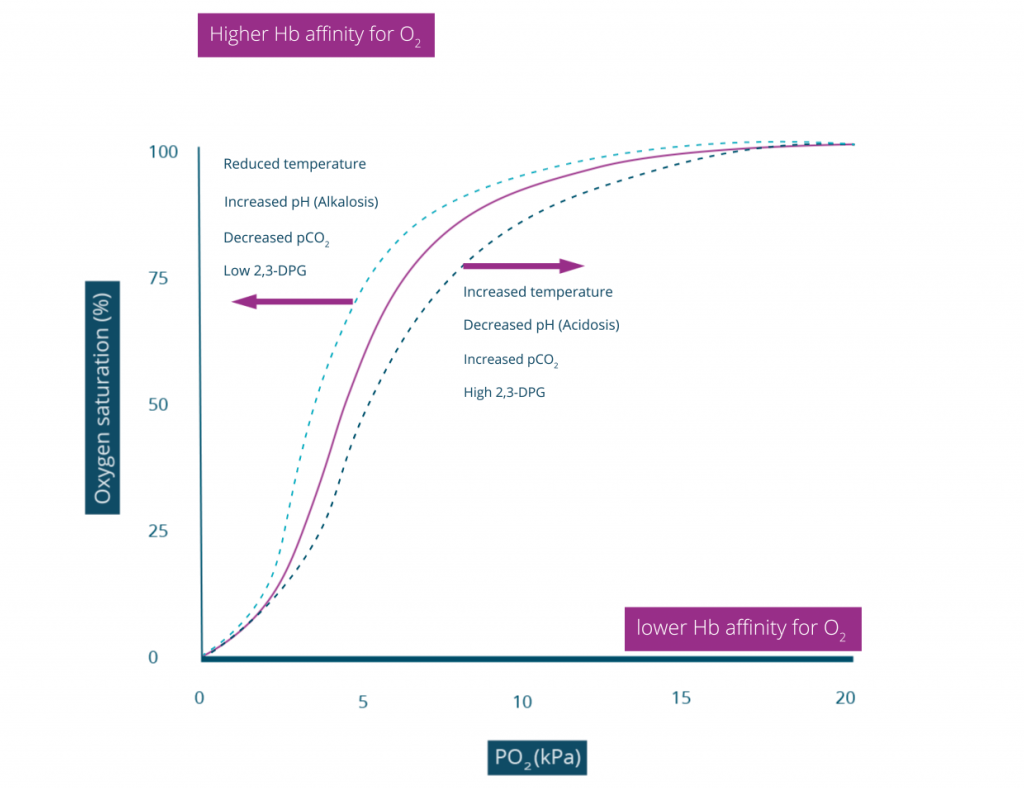Factors affecting Haemoglobin affinity
There are lots of factors that affect the affinity of Haemoglobin for oxygen, causing a shift to the left (increased oxygen affinity) or a shift to the right (decreased oxygen affinity).

The following factors can have a remarkable effect on the haemoglobin’s ability to pick up and release oxygen.affect the shape of the oxyhaemoglobin dissociation curve, and therefore affect the affinity for oxygen, include:
- Temperature
- Partial pressure of CO2
- pH
- 2,3 Diphosphoglycerate (2,3 DPG)
Increases in temperature, increases in carbon dioxide concentration, decreases in pH (more acidic) and increases in 2,3 diphosphoglycerate (2,3 DPG), shift the curve to the right; the haemoglobin binds to oxygen with less affinity, releasing it more easily to the cells that need it.
If you consider one specific state that requires a rapid oxygen delivery system, this concept begins to make sense. During exercise, the body temperature increases, more carbon dioxide is produced due to the increased demand for ATP, and there is more lactic acid produced. The haemoglobin has a lower affinity for oxygen, and therefore releases it more readily to the cells that are participating in ‘internal respiration’.
Generally speaking, a pulse oximetry value of 92% or higher is clinically acceptable. Any lower than 92%, the oxyhaemobglobin dissociation curve starts to become more steep and the patient’s oxygen content of the blood is much less stable.
Remember, any state the resembles exercise (increased temperature, increased carbon dioxide, more acidic environment) will result in the oxyhaemoglobin curve shifting to the right; the haemoglobin has less affinity for oxygen, and therefore unloads it more readily at the cells.
Factors affecting Haemoglobin affinity
There are lots of factors that affect the affinity of Haemoglobin for oxygen, causing a shift to the left (increased oxygen affinity) or a shift to the right (decreased oxygen affinity).

The following factors can have a remarkable effect on the haemoglobin’s ability to pick up and release oxygen.affect the shape of the oxyhaemoglobin dissociation curve, and therefore affect the affinity for oxygen, include:
- Temperature
- Partial pressure of CO2
- pH
- 2,3 Diphosphoglycerate (2,3 DPG)
Increases in temperature, increases in carbon dioxide concentration, decreases in pH (more acidic) and increases in 2,3 diphosphoglycerate (2,3 DPG), shift the curve to the right; the haemoglobin binds to oxygen with less affinity, releasing it more easily to the cells that need it.
If you consider one specific state that requires a rapid oxygen delivery system, this concept begins to make sense. During exercise, the body temperature increases, more carbon dioxide is produced due to the increased demand for ATP, and there is more lactic acid produced. The haemoglobin has a lower affinity for oxygen, and therefore releases it more readily to the cells that are participating in ‘internal respiration’.
Generally speaking, a pulse oximetry value of 92% or higher is clinically acceptable. Any lower than 92%, the oxyhaemobglobin dissociation curve starts to become more steep and the patient’s oxygen content of the blood is much less stable.
Remember, any state the resembles exercise (increased temperature, increased carbon dioxide, more acidic environment) will result in the oxyhaemoglobin curve shifting to the right; the haemoglobin has less affinity for oxygen, and therefore unloads it more readily at the cells.

